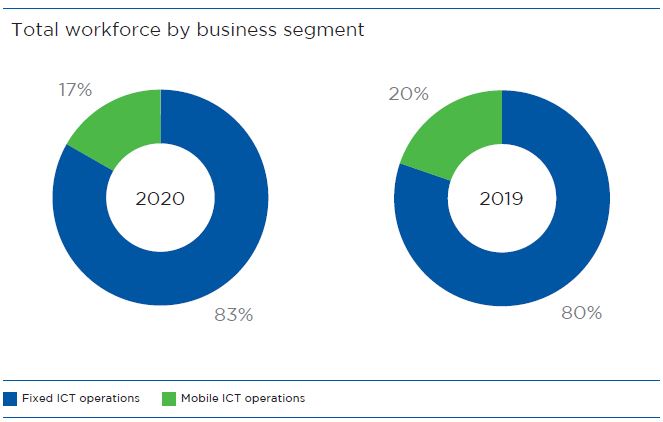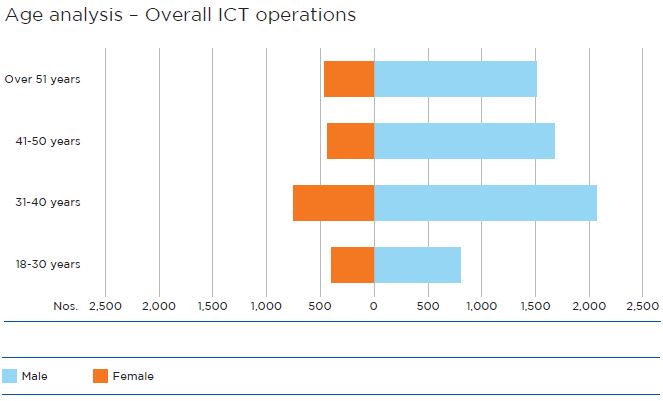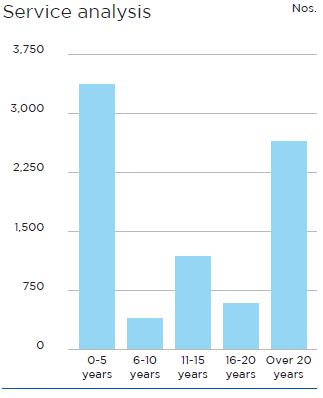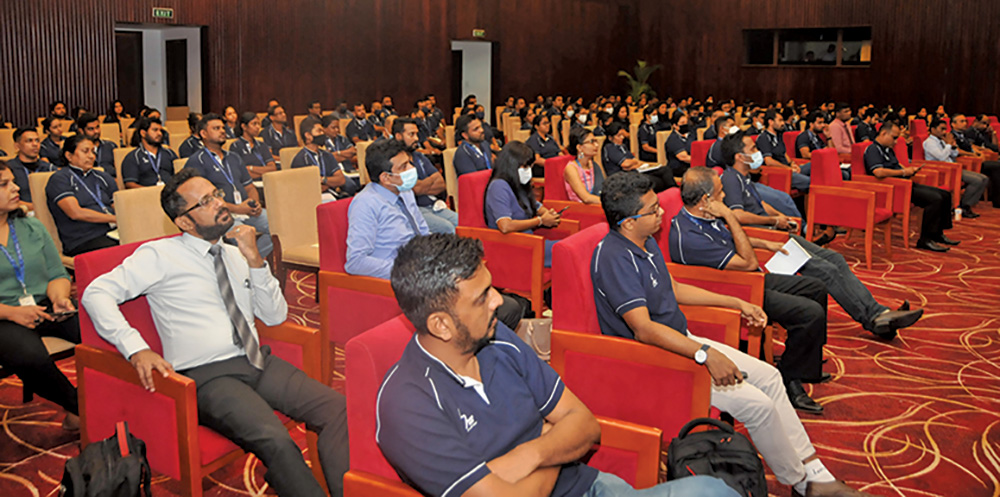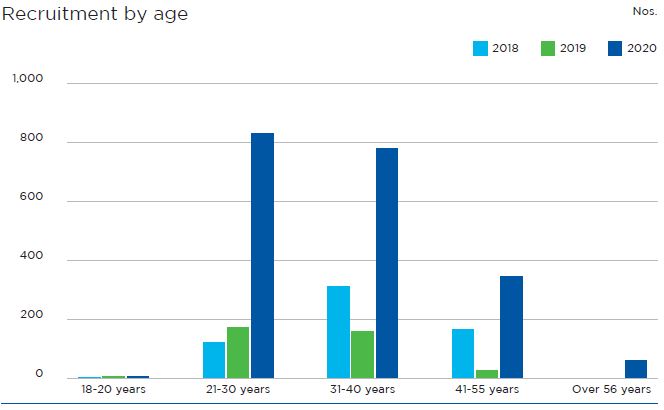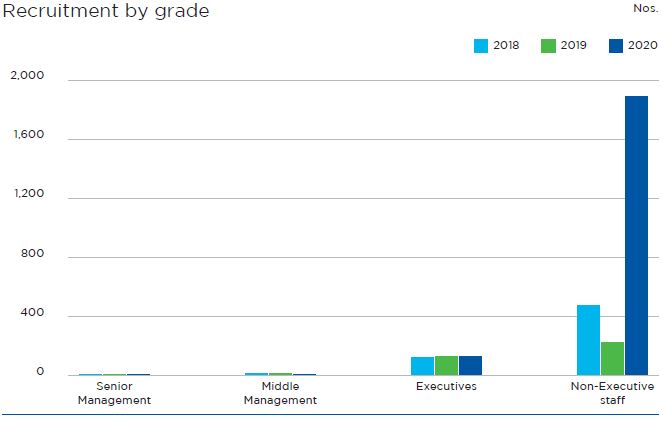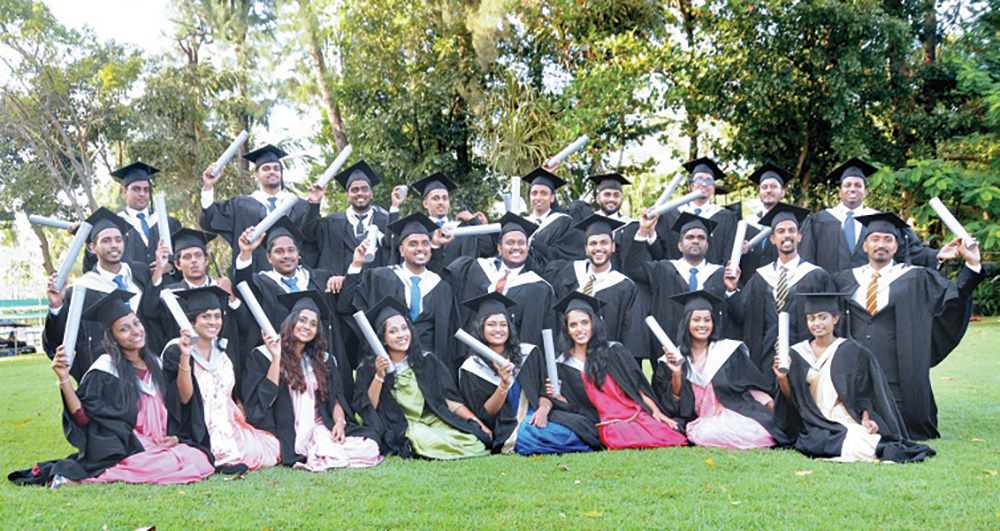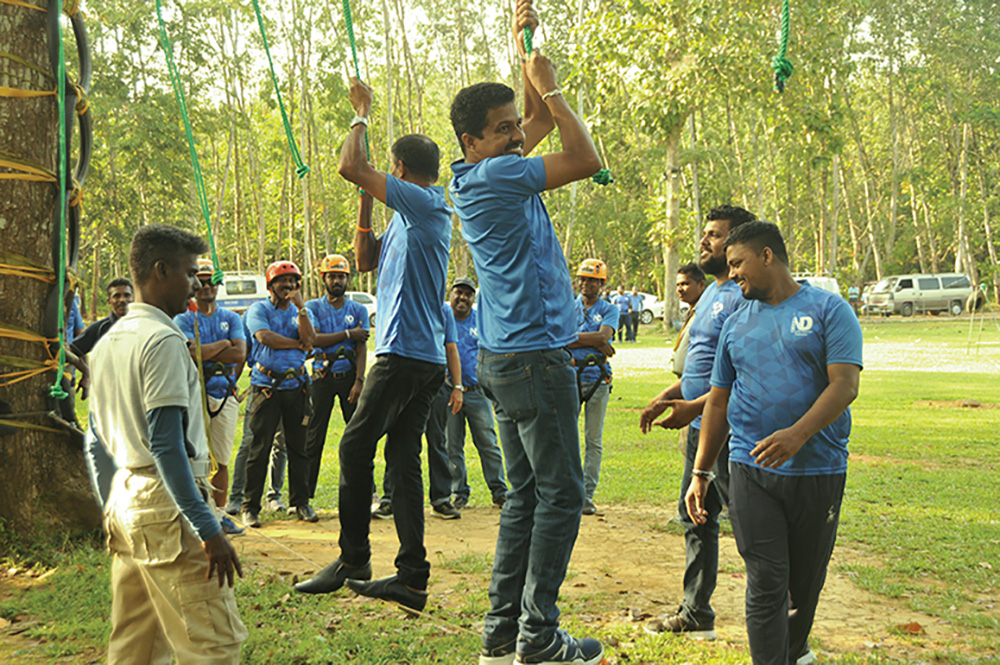
Creating shared success
employee capital
Employee Capital
SLT’s employee capital is one of SLT’s most fundamental resources and is at the heart of its business model and value creation process. The people of SLT are tasked with executing the corporate strategy and representing the corporate brand with proficiency and integrity. SLT strives to create an environment in which the employees feel valued, recognised, and connected to SLT’s wider purpose. This, in turn, empowers them to do their best work, realise their full potential, and drive the success of the Company.
Key Initiatives during 2020
The challenges brought about by the COVID-19 pandemic made 2020 an unprecedented year. It was imperative to provide uninterrupted services to SLT customers, whilst safeguarding the employees’ health. At the onset of the first wave of COVID-19 a cross-functional Crisis Management Team was established to organise and oversee SLT’s response. The Business Continuity Plan was implemented covering all key areas of the organisation including safeguarding employees’ health and safety. The top management was present in office almost every day to make swift decisions as the situation evolved. The staff were assigned to work around the clock to maintain operations, with technical teams designated to attend to all service inquiries, and field teams deployed to attend onsite service concerns. Work was implemented on a roster system to minimise employee visits to work locations. When their presence was required, employees were given clear instructions on health and safety protocols and provided with PPE and sanitisers.
For the majority of the Company’s staff, Work From Home (WFH) arrangements were implemented and remote access to systems like ERP and CRM were facilitated. A flexible approach was the order of the day – staff took on multiple roles, and were allocated to areas of need. Staff were kept abreast of all developments and decisions immediately through email, SMS, WhatsApp and Viber, and work processes were made as simple as possible to allow staff to efficiently and accurately meet customer experiences during this difficult period. Transport was provided to all employees in curfew areas, whilst looking after all their other requirements. The Company was able to provide uninterrupted service to customers during the lockdown due to the commitment, adaptability, and resilience of its people.
To protect the Company’s most vulnerable staff members, many initiatives were implemented to better care for the employees. These included conducting periodic random PCR and Antigen tests and having designated isolation rooms in every office, along with a transit centre, to house employees who contract COVID-19 until they can be transported to quarantine. Preparations have been made in hotels to accommodate infected employees during their quarantine period, including the Company’s Retreat Center at Poththodai, Negombo. 8,000 priority vaccines have been requested from the Ministry of Health.
It is noteworthy that the Company managed to successfully recruit all staff of Human Capital Solutions (HCS) who have been deployed at SLT, numbering about 1,800, within short period of 3 weeks. Competency assessments and development plans were designed for Sales Staff (RTOM and SME) to further strengthen the sales function and in promoting a sales culture. Also, a new organisational structure was implemented in order to better align the growth and development of the Company with requirements of future.
Workforce profile
A diverse culture comprising people with different social and cultural backgrounds and a variety of life, educational, and work experiences is essential to providing a superior quality of service. A workforce that is truly representative of Sri Lanka has the potential to support market relevance and act as a catalyst for innovation. SLT is committed to promoting diversity through all levels of the organisation, up to and including leadership, and are particularly proud of the strides that have made in, including women in the workforce. Despite being a tech company, a field in which women are traditionally underrepresented, women comprise 25% of our workforce.
Total workforce by employment type
| Type of employment | Fixed ICT | Mobile ICT | Overall ICT | ||||||
| 2020 | 2019 | 2018 | 2020 | 2019 | 2018 | 2020 | 2019 | 2018 | |
| Permanent | 6,692 | 5,217 | 5,364 | 1,313 | 1,165 | 1,165 | 8,005 | 6,382 | 6,529 |
| Contract | 83 | 18 | 8 | 49 | 122 | 113 | 132 | 140 | 121 |
| Outsourced | 12 | 1,667 | 1,869 | 30 | 162 | 156 | 42 | 1,829 | 2,025 |
| Total | 6,787 | 6,902 | 7,241 | 1,392 | 1,449 | 1,434 | 8,179 | 8,351 | 8,675 |
Total workforce by gender
| Grade | Male | Female | Total | ||||||
| 2020 | 2019 | 2018 | 2020 | 2019 | 2018 | 2020 | 2019 | 2018 | |
| Fixed ICT operations | 5,050 | 3,820 | 3,940 | 1,725 | 1,415 | 1,432 | 6,775 | 5,235 | 5,372 |
| Mobile ICT operations | 976 | 908 | 892 | 386 | 379 | 386 | 1,362 | 1,287 | 1,278 |
| Overall ICT operations | 6,026 | 4,728 | 4,832 | 2,111 | 1,794 | 1,818 | 8,137 | 6,522 | 6,650 |
Excludes both outsourced and part-time staff
Employees by business segment, age and gender
Fixed ICT operations
| Age group | Male | Female | Total | ||||||
| 2020 | 2019 | 2018 | 2020 | 2019 | 2018 | 2020 | 2019 | 2018 | |
| 18-30 years | 590 | 140 | 134 | 298 | 40 | 63 | 888 | 180 | 197 |
| 31-40 years | 1,564 | 940 | 979 | 558 | 490 | 424 | 2,122 | 1,430 | 1,403 |
| 41-50 years | 1,454 | 1,300 | 1,329 | 396 | 430 | 468 | 1,850 | 1,730 | 1,797 |
| Over 51 years | 1,442 | 1,440 | 1,498 | 473 | 455 | 477 | 1,915 | 1,895 | 1,975 |
| Total | 5,050 | 3,820 | 3,940 | 1,725 | 1,415 | 1,432 | 6,775 | 5,235 | 5,372 |
Excluding both outsourced and part-time staff
Mobile ICT operations
| Age group | Male | Female | Total | ||||||
| 2020 | 2019 | 2018 | 2020 | 2019 | 2018 | 2020 | 2019 | 2018 | |
| 18-30 years | 204 | 224 | 234 | 109 | 118 | 131 | 313 | 342 | 365 |
| 31-40 years | 492 | 447 | 451 | 216 | 212 | 213 | 708 | 659 | 664 |
| 41-50 years | 219 | 182 | 154 | 54 | 45 | 37 | 273 | 227 | 191 |
| Over 51 years | 61 | 55 | 53 | 7 | 4 | 5 | 68 | 59 | 58 |
| Total | 976 | 908 | 892 | 386 | 379 | 386 | 1,362 | 1,287 | 1,278 |
Excluding both outsourced and part-time staff
Employees based on grade
| Grade | Fixed ICT | Mobile ICT | ||||
| 2020 | 2019 | 2018 | 2020 | 2019 | 2018 | |
| Senior Management | 72 | 60 | 61 | 67 | 65 | 66 |
| Middle Management | 118 | 123 | 113 | 376 | 356 | 352 |
| Executives | 705 | 787 | 776 | 890 | 863 | 857 |
| Non-Executive staff | 5,880 | 4,265 | 4,422 | 29 | 3 | 3 |
| Total | 6,775 | 5,235 | 5,372 | 1,362 | 1,287 | 1,278 |
Excluding both outsourced and part-time staff
Employees based on grade and gender
| Grade | Fixed ICT | Mobile ICT | ||||
| 2020 | 2019 | 2018 | 2020 | 2019 | 2018 | |
| Senior Management – Female | 11 | 10 | 10 | 7 | 7 | 8 |
| Senior Management – Male | 61 | 50 | 51 | 60 | 58 | 58 |
| Middle Management – Female | 22 | 21 | 20 | 81 | 77 | 74 |
| Middle Management – Male | 96 | 102 | 93 | 295 | 279 | 278 |
| Executives – Female | 267 | 269 | 262 | 297 | 295 | 304 |
| Executives – Male | 438 | 518 | 514 | 593 | 568 | 553 |
| Non-Executive staff – Female | 1,425 | 1,115 | 1,140 | 1 | 0 | 0 |
| Non-Executive staff – Male | 4,455 | 3,150 | 3,282 | 28 | 3 | 3 |
| Total – Female | 1,725 | 1,415 | 1,432 | 386 | 379 | 386 |
| Total – Male | 5,050 | 3,820 | 3,940 | 976 | 908 | 892 |
Excluding both outsourced and part-time staff
| Number of years of service | Fixed ICT | Mobile ICT | Overall ICT | ||||||
| 2020 | 2019 | 2018 | 2020 | 2019 | 2018 | 2020 | 2019 | 2018 | |
| 0-5 years | 2,806 | 1,054 | 893 | 556 | 405 | 455 | 3,362 | 1,459 | 1,348 |
| 6-10 years | 192 | 112 | 203 | 206 | 220 | 286 | 398 | 332 | 489 |
| 11-15 years | 804 | 960 | 878 | 380 | 403 | 436 | 1,184 | 1,363 | 1,314 |
| 16-20 years | 387 | 269 | 325 | 198 | 205 | 56 | 585 | 474 | 381 |
| Over 20 years | 2,586 | 2,840 | 3,073 | 53 | 54 | 45 | 2,639 | 2,894 | 3,118 |
| Total | 6,775 | 5,235 | 5,372 | 1,393 | 1,287 | 1,278 | 8,168 | 6,522 | 6,650 |
Excluding both outsourced and part-time staff
Employees worked from home by grade/gender – Fixed ICT Operations
| Grade | Male | Female | Total |
| Executive | 406 | 223 | 629 |
| Non-executive | 1,935 | 702 | 2,637 |
| Total | 2,341 | 925 | 3,266 |
Recruitement & Talent Development
SLT’s talent sourcing and management strategy which involves attracting, developing, and retaining the right people is a driving factor for its business success and long-term sustainability. This strategy is not simply about hiring staff with the requisite skills. It involves a more holistic approach to creating the right values and culture where staff are empowered to develop in a rapidly evolving operating environment. To that end, the following pillars are prioritised:
- Identifying the short-term and long-term competency requirements of the organisation in line with organisational strategic plans and objectives
- Designing, developing and sourcing learning solutions with learning objectives to bridge the identified competency gaps
- Timely delivery of learning solutions through effective methodologies utilising physical and technological resources
- Evaluating the learning outcomes and ensure continuous improvements
During 2020, the entire Human Resources process was digitalised, and an online application for external recruitment was introduced, along with online interviews and placements for interns. In addition, all promotion procedures were digitalised, and a plan is in place to introduce an online examination for recruitment.
Despite the challenges of the pandemic, there was no downsizing of staff. SLT recruite approximately 1,800 employees of its subsidiary; Human Capital Solutions (HCS) as permanent employees over a period of three weeks. This is a notable feat for a corporate to recruit such a significant number of employees during the pandemic. This aligns with the Company’s broader recruitment strategy. SLT has a robust recruitment procedure, involving sound interview and trade testing processes to absorb quality individuals directly to SLT on a permanent basis.
Recruitment by age and business segment
| Age | Fixed ICT | Mobile ICT | Overall ICT | ||||||
| 2020 | 2019 | 2018 | 2020 | 2019 | 2018 | 2020 | 2019 | 2018 | |
| 18-20 years | 5 | 0 | 0 | 0 | 3 | 2 | 5 | 3 | 2 |
| 21-30 years | 774 | 96 | 18 | 55 | 75 | 103 | 829 | 171 | 121 |
| 31-40 years | 707 | 141 | 295 | 70 | 17 | 15 | 777 | 158 | 310 |
| 41-55 years | 317 | 24 | 162 | 29 | 1 | 2 | 346 | 25 | 164 |
| Over 56 years | 60 | 0 | 0 | 2 | 0 | 0 | 62 | – | – |
| Total | 1,863 | 261 | 475 | 156 | 96 | 122 | 2,019 | 357 | 597 |
Excludes both outsourced and part-time staff
Recruitment by grade and business sgement
| Grade | Fixed ICT | Mobile ICT | Overall ICT | ||||||
| 2020 | 2019 | 2018 | 2020 | 2019 | 2018 | 2020 | 2019 | 2018 | |
| Senior Management | 1 | 1 | 1 | – | – | – | 1 | 1 | 1 |
| Middle Management | – | – | – | 5 | 10 | 8 | 5 | 10 | 8 |
| Executives | 3 | 41 | 5 | 122 | 86 | 114 | 125 | 127 | 119 |
| Non-Executive staff | 1,859 | 219 | 469 | 29 | – | – | 1,888 | 219 | 469 |
| Total | 1,863 | 261 | 475 | 156 | 96 | 122 | 2,019 | 357 | 597 |
Excludes both outsourced and part-time staff
Turnover
Turnover at SLT may occur through the following scenarios:
- Employees may conclude their employment at SLT subject to giving prior notice as per their letters of appointment.
- SLT may choose to terminate an employee’s employment subject to the provisions of the respective labour agreements.
- Retirement at 55 years of age, with extensions up to 60 years of age subject to performance, discipline, conduct and with discretion of the Management.
SLT’s employee turnover is extremely low – at 5.9% in 2020 (including retirements). This is a strong affirmation of the Company’s value proposition and brand as an employer offering life-long careers. SLT aims to create value for its employees by providing job security, industry-leading remuneration and benefits, a healthy work-life balance, fulfilling roles that allow staff to utilise their skills and talents, and opportunities for training, development, and advancement.
Employee turnover by grade and business segment (%)
| Grade | Fixed ICT | Mobile ICT | ||||
| 2020 | 2019 | 2018 | 2020 | 2019 | 2018 | |
| Senior Management | 9.5 | 11.8 | 8.2 | 0.23 | 0.16 | 0.32 |
| Middle Management | 1.6 | 6.0 | 5.3 | 1.51 | 2.03 | 1.68 |
| Executives | 7.8 | 11.6 | 10.9 | 3.70 | 4.77 | 3.91 |
| Non-Executive staff | 5.6 | 6.9 | 10.7 | 0.08 | 0.00 | 0.00 |
| Total | 5.9 | 7.6 | 10.6 | 5.51 | 6.95 | 5.91 |
Excludes both outsourced and part-time staff
Employee turnover by age and business segment (%)
| Age | Fixed ICT | Mobile ICT | ||||
| 2020 | 2019 | 2018 | 2020 | 2019 | 2018 | |
| 18-20 years | 0.0 | 0.0 | 0.0 | 0.00 | 0.00 | 0.00 |
| 21-30 years | 0.8 | 12.6 | 8.4 | 1.96 | 2.97 | 2.79 |
| 31-40 years | 0.8 | 2.6 | 1.9 | 2.34 | 2.97 | 2.47 |
| 41-50 years | 0.4 | 1.5 | 3.6 | 0.45 | 0.39 | 0.24 |
| 51-55 years | 1.2 | 3.1 | 12 | 0.38 | 0.08 | 0.08 |
| Over 56 years | 33 | 27.9 | 28.3 | 0.38 | 0.55 | 0.32 |
| Total | 5.9 | 7.6 | 10.6 | 5.51 | 6.95 | 5.91 |
Excludes both outsourced and part-time staff
Employee turnover based on business segment (%)
| segment | Male | Female | ||||
| 2020 | 2019 | 2018 | 2020 | 2019 | 2018 | |
| Fixed ICT operations | 6.00 | 8.40 | 11.35 | 5.50 | 5.50 | 8.70 |
| Mobile ICT operations | 4.00 | 4.22 | 4.15 | 1.51 | 2.73 | 1.76 |
Excludes both outsourced and part-time staff
Turnover includes retirements
Training and development
SLT’s fundamental training objective, in line with its transition to a digital services provider, is to create a highly digitally-capable workforce. One of the side-effects of the COVID-19 pandemic has been to spur digital transformation. With the introduction of WFH systems, the automation of HR functions, and shift of training programmes (on Python, Data Science, and AI) to online platforms, employees are being exposed to an increasingly digitalised workplace. The staff are also encouraged to embrace new ways of working and explore opportunities to develop new skills that will enable to thrive in the digital space.
Employee training and development is conducted at an individual and departmental level. Employees are provided with a combination of formal training, on-the-job experience, and regular feedback from their managers through an appraisal system helps both employees and management to identify areas that require more focus. During the year under review, employee skill assessment methodology was enhanced and the Company has a rigorous internal certification programme in which employees are assessed and certified every three years.
The SLT Training Centre has established a partnership with the University of Hartfordshire to offer UGC recognised Engineering degree programmes in
Sri Lanka, in three disciplines – computer science, telecommunication and electrical engineering. The Training Centre also offers several other programmes including City & Guilds; Pearson courses. The Centre comprises three fully equipped centres – two main centres at Welisara and Moratuwa and regional training centres at Peradeniya. This year, as a result of the pandemic, virtual and online training was encouraged, and limited the number of in-person sessions. The online training programmes served 1,609 total participants across 6,138 training hours. In all physical classrooms, Government guidelines were followed in implementing safety measures.
Beyond these formal classroom and online training spaces, SLT seeks to promote a culture of continuous development through access to learning experiences that are more informal and more loosely structured. A large component of this is tapping into SLT’s rich store of tacit knowledge – built over 163 years of operations – through formal and informal social interactions and discussions.
SLT conducted 360 training programmes during the year for 7,324 participants, covering a total of 11,108 training days converted to 66,649 hours of training.
Training programmes conducted in 2020
The range of training programmes covered induction of new recruits, introduction to Data Science, awareness series on SLT Technical Platforms and overall network (Data Centre, ISP etc.) and Python Programming for Data Science. The programmes also included Employee Engagement for better Customer Engagement, Contact Centre Team Leaders Workshop and Project Management Professional programme.
Hours of training by grade
Fixed ICT
| Grade | Total hours |
Total participants |
| Senior Management | 1,705 | 195 |
| Middle Management | 7,626 | 1,240 |
| Non-executives | 57,318 | 5,889 |
| Total | 66,649 | 7,324 |
Mobile ICT
| Grade | Total hours |
Total
participants |
| Senior Management | 1,361 | 97 |
| Middle Management | 4,594 | 347 |
| Executives | 5,752 | 418 |
| Non-executives | 0 | 0 |
| Total | 11,707 | 862 |
Excludes both outsourced and part-time staff
Hours of training undergone during the year by gender and skills type
Fixed ICT
| Type | Number of employees | Number of person hours of training | ||||
| Male | Female | Total | Male | Female | Total | |
| Technical skills | 2,864 | 803 | 3,667 | 27,976 | 1,303 | 29,279 |
| Soft skills (Non-Technical) | 2,548 | 1,109 | 3,657 | 24,586 | 12,784 | 37,370 |
Mobile ICT
| Type | Number of employees | Number of person hours of training | ||||
| Male | Female | Total | Male | Female | Total | |
| Technical skills | 101 | 56 | 157 | 332 | 208 | 540 |
| Soft skills (Non-Technical) | 222 | 106 | 328 | 3,404 | 1,338 | 4,742 |
| Other | 284 | 118 | 402 | 4,221 | 2,310 | 6,531 |
Benefits and promotions
Despite the many economic challenges brought about by the pandemic this year, SLT guaranteed that employees would be granted their full salary and benefits, and provided a risk allowance and an additional four-month bonus to all employees. The Company strongly felt it was important to affirm and strengthen its commitment to the staff in a period of much anxiety and uncertainty about the future. This financial commitment was rare in the corporate sector this year, and demonstrates SLT’s position as a top employer brand. SLT maintains a remuneration policy in par with market rates.
Employees of SLT enjoy a broad range of benefits and welfare initiatives, including:
- Attractive EPF/ETF contributions
- Attractive bonuses paid each year
- A maximum leave bonus of one month for unutilised leave
- Medical centre, and Agrahara Health Insurance Scheme
- Financial support for higher education, including MSc, MBA, and other postgraduate studies
- Training programmes
- Workmens’ compensation for disabilities/accidents during work
- Allowances for risk, overnight, subsistence, transport, meals, foreign training, etc.
- Monthly and annual sales programmes
- Gratuity
- Death donations to family members
- Vehicle scheme
- Holiday bungalows
- Cafeteria facilities
- Loan facilities and reimbursement of housing loan interest
- Leave entitlements, overseas leave, and leave for Government elections
- Telephone subscriptions and mobile phone purchase reimbursement
- Fitness programmes including Zumba, yoga, karate, swimming, cycling, etc.
- Sports activities and associations for cricket, football, netball, athletics, volleyball, table tennis, badminton, etc.
- Religious activities such as Buddhist programmes, Christmas activities, etc
Opportunities for promotions are available to employees based on their professional qualifications, performance, and experience. Employees are eligible for promotions if they qualify for the criteria defined in the SLT Staff Recruitment and Promotion Scheme. Candidates are selected for promotions through written examinations and/or interviews.
SLT places heavy emphasis on grooming talent from within through succession planning and leadership development initiatives. This year, SLT completed a plan for the top Management to ensure a strong leadership pipeline. Based on this plan, individual development plans will be created for identified officers. During the year, 79 supernumerary promotions were granted and 768 non-executive staff and 97 executive staff were promoted.
Employee relations and engagement
The year under review presented unique challenges for employee engagement following the COVID-19 pandemic. The Company’s multi-generational staff representing a wide cross-section of Sri Lankan society, faced numerous challenges and SLT developed a range of WFH options to create stress-free conditions. Home-to-Field concept was created for field and operational staff, to address customer issues in a speedy and efficient manner. Work from pods enabled staff to work at locations close to their home. The Company SLT focused on team morale and connection by creating various virtual learning programmes and having frequent contact through online meetings.
Unions and grievance handling
SLT has maintained open, transparent dialogues with trade unions since its privatisation. The strength of these relationships is evident in the fact that despite having 25 trade unions and nearly all employees being union members, SLT have not had any work lost time due to industrial disputes. The Company maintains an open-door policy with trade unions and at least one formal discussion is conducted with all trade unions every three months. SLT considers unions as stakeholder and partners and seek to involve them in the decision-making processes.
Furthermore, a Grievance Handling Committee has been established along with a systematic and comprehensive mechanism to handle any staff grievances and issues. A detailed whistle-blowing policy is in place to allow any employee to safely and anonymously report any acts of misconduct that they have been subject to or witnessed.
Future outlook
In 2021, SLT will capitalise on the gains made in its digital transformation. At the heart of it is, recognising that the world of work is undergoing a rapid transformation. Even as digitalisation and artificial intelligence are increasingly shaping the job roles, SLT will continue to adapt and be an agile organisation, nurturing a team of passionate, productive, and self-driven workforce.
SLT’s strategy for the next year involves retaining the WFH, Work from Pod (WFP), and Home to Field concepts, and developing policies to make them permanent fixtures in the Company’s range of work options. The Company will offer flexible working hours, and transfer majority of its training to online platforms. These options will put SLT people in the best position to succeed and create value for the clients.

